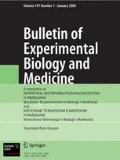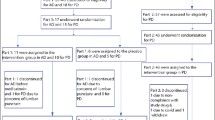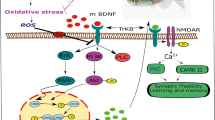We studied the role of proline-specifi c peptidases in the pathogenesis of Alzheimer’s disease. Testing of conditioned passive avoidance 24 h after learning showed that chronic administration of scopolamine to rats 4-fold reduced the latency of entry into the dark chamber in comparison with controls (intact animals). Activity of prolyl endopeptidase was signifi cantly higher than in the controls in both the cortex and hippocampus. Changes in dipeptidyl peptidase IV activity were observed only in the cortex. Injection of AF-64A toxin into Meynert nucleus basalis reduced the latency of entry into the dark compartment by 75% in comparison with that in sham-operated and intact controls. Prolyl endopeptidase activity was reduced in the frontal cortex and hippocampus, but not in hypothalamus. Changes in dipeptidyl peptidase IV activity were detected only in the frontal cortex.
Similar content being viewed by others
References
I. P. Ashmarin and S. V. Koroleva, Advanced Functional Neurochemistry, Eds. S. A. Dambinova and A. V. Arutjunian [in Russian], St. Petersburg (2003), pp. 85-94.
N. N. Zolotov, O. A. Kutepova, T. A. Voronina, et al., Dokl. Akad. Nauk SSSR, 317, 234-237 (1991).
A. Aguilar-Valles, E. Sánchez, P. de Gortari, et al., Neurochem. Int., 50, No. 2, 404-417 (2007).
S. L. Bernstein, N. F. Dupuis, N. D. Lazo, et al., Nat. Chem., 1, No. 4, 326-331 (2009).
L. Bertram, Int. Rev. Neurobiol., 84, 167-184 (2009).
M. M. Bradford, Anal. Biochem., 72, 248-254 (1976).
A. Fisher and I. Hanin, Ann. Rev. Pharmacol. Toxicol., 26, 161-181 (1986).
F. Fonnum, J. Neurochem., 24, No. 2, 407-409 (1975).
A. J. Jalkanen, J. J. Hakkarainen, M. Lehtonen, et al., Basic. Clin. Pharmacol. Toxicol., 109, No. 6, 443-451 (2011).
P. T. Mannisto, P. Tuomainen, O. Kutepova, et al., Pharmacol. Biochem. Behav., 49, No. 1, 33-40 (1994).
R. Mentlein, Regul. Pept., 85, No. 1, 9-24 (1999).
L. Osherovich, Science Business Exchange, No. 1, 1-2 (2011).
Y. S. Park, H. J. Jang, K. H. Lee, et al., J. Agric. Food Chem., 54, No. 4, 1238-1242 (2006).
S. Rossner, I. Schulz, U. Zeitschel, et al., Neurochem. Res., 30, Nos. 6-7, 695-702 (2005).
Author information
Authors and Affiliations
Corresponding author
Additional information
Translated from Byulleten’ Eksperimental’noi Biologii i Meditsiny, Vol. 153, No. 5, pp. 628-630, May, 2012
Rights and permissions
About this article
Cite this article
Nazarova, G.A., Kolyasnikova, K.N. & Zolotov, N.N. Changes in Activity of Proline-Specific Peptidases in Rat Model for Dementia of Alzheimer’s Type. Bull Exp Biol Med 153, 674–676 (2012). https://doi.org/10.1007/s10517-012-1796-3
Received:
Published:
Issue Date:
DOI: https://doi.org/10.1007/s10517-012-1796-3




